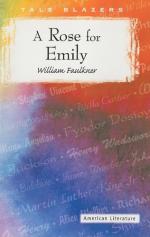|
This section contains 4,392 words (approx. 15 pages at 300 words per page) |

|
SOURCE: “Irony and Isolation: Narrative Distance in Faulkner's ‘A Rose for Emily,’” in The Faulkner Journal, Vol. 8, No. 2, Spring, 1993, pp. 3–12.
In the following essay, Rodman argues that, rather than representing the community, the narrator of “A Rose for Emily” is just as isolated and alienated as Emily.
The critical consensus remains that the narrator of “A Rose for Emily” speaks for his community.1 The narrator has been seen as “community representative” (Allen 187); “[t]he narrating character in ‘A Rose for Emily’ plays no active role, but his opinions of Emily Grierson directly reflect his community's attitude” (Ruppersburg 15). For another critic, “the first person narrator … seems to represent the generalized voice of Jefferson” (Millgate, Achievement 272). Cleanth Brooks wrote:
In “A Rose for Emily” … there is a narrator who … clearly speaks for the community. For example, he never says “I thought,” or “I knew,” or “I believed,” but speaks rather...
|
This section contains 4,392 words (approx. 15 pages at 300 words per page) |

|


